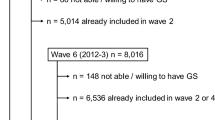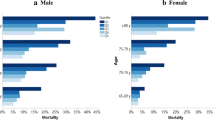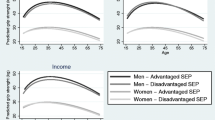Abstract
Grip strength (GS) has an age- and gender-dependent decline with advancing age. One study comparing GS among extremely old show a North–South gradient with lowest GS in Italy compared to France (intermediary) and Denmark (highest) even after adjusting for confounders. As GS is associated with higher rates of functional decline and mortality, and thus may be used as a health indicator, it is of interest to examine whether the results on extremely old can be reproduced in a large-scale European survey. GS was measured in a cross-sectional population-based sample of 27,456 individuals aged 50+ in 11 European countries included in the SHARE survey. We made a cross-country comparison of the age trajectory of GS in both genders. Northern-continental European countries had higher GS than southern European countries even when stratifying by age and gender and controlling for height, weight, education, health and socioeconomic status. The relative excess was found to be 11% and the absolute difference 5.0 kg for 50- to 54-year-old men, increasing to 28% and 6.9 kg among 80+ year-old men. The corresponding figures for women were 16% and 4.3 kg, and 21% and 3.5 kg, respectively. Southern European countries have lower GS in the age range 50+ year. Gene–environment interactions may explain country-specific differences. The use of GS in cross-national surveys should control not only for age and gender, but also for nationality.


Similar content being viewed by others
References
Albert SM, Alam M, Nizamuddin M (2005) Comparative study of functional limitation and disability in old age: Delhi and New York City. J Cross Cult Gerontol 20:231–241
Albrand G, Munoz F, Sornay-Rendu E, DuBoeuf F, Delmas PD (2003) Independent predictors of all osteoporosis-related fractures in healthy postmenopausal women: the OFELY Study. Bone 32:78–85
Alfaro-Acha A, Snih SA, Raji MA, Kuo YF, Markides KS, Ottenbacher KJ (2006) Hand grip strength and cognitive decline in older Mexican Americans. J Gerontol Med Sci 61A:859–865
Börsch-Supan A, Brugiavini A, Jürges H, Mackenbach J, Siegrist J, Weber G (2005a) Health, ageing and retirement in Europe. First results from the survey of health, ageing and retirement in Europe. Mannheim Research Institute for the Economics of Ageing, Mannheim
Börsch-Supan A, Hank K, Jürges H (2005) A new comprehensive and international view on aging: Introducing the survey of ‘Health, Ageing and Retirement in Europe’. Eur J Ageing 2:245–253
Cesari M, Penninx BWJH, Pahor M, Lauretani F, Corsi AM, Williams GR, Guralnik JM, Ferruci L (2004) Inflammatory markers and physical performance in older persons: the InCHIANTI study. J Gerontol Med Sci 59A:242–248
Christelis D, Jappelli T, Padula M (2005) Wealth and portofolio composition. In: Börsch-Supan A, Brugiavini A, Jürges H, Mackenbach J, Siegrist J, Weber G (eds) Health, ageing and retirement in Europe. First results from the survey of health, ageing and retirement in Europe. Mannheim Research Institute for the Economics of Ageing, Mannheim, pp 310–317
Era P, Rantanen T, Avlund K, Gause-Nilsson I, Heikkinen E, Schroll M, Steen B, Suominen H (1994) Maximal isometric muscle strength and anthropometry in 75-year-old men and women in three Nordic localities. Scand J Med Sci Sports 4:26–31
Frederiksen H, Gaist D, Petersen HC, Hjelmborg J, McGue M, Vaupel JW, Christensen K (2002) Hand grip strength: a phenotype suitable for identifying genetic variants affecting mid- and late-life physical functioning. Genet Epidemiol 23:110–122
Frederiksen H, Hjelmborg J, Mortensen J, McGue M, Vaupel JW, Christensen K (2006) Age trajectories of grip strength: cross-sectional and longitudinal data among 8, 342 Danes aged 46 to 102. Ann Epidemiol 16:554–562
Fujita Y, Nakamura Y, Hiraoka J, Kobayashi K, Sakata K, Nagai M, Hiroshi Y (1995) Physical-strength tests and mortality among visitors to health-promotion centers in Japan. J Clin Epidemiol 48:1349–1359
Gallagher D, Visser M, de Meersman RE, Sepulveda D, Baumgartner RN, Pierson RN, Harris T, Heymsfield SB (1997) Appendicular skeletal muscle mass: effects of age, gender, and ethnicity. J Appl Physiol 83:229–239
Goodpaster B, Won Park S, Harris T, Kritchevsky SB, Nevitt M, Schwartz AV, Simonsick EM, Tylavsky FA, Visser M, Newmann AB (2006) The loss of skeletal muscle strength, mass and quality in older adults: the health, aging and body composition study. J Gerontol A Biol Sci Med Sci 61:1059–1064
Goodpaster BH, Chomentowski P, Ward BK, Rossi A, Glynn NW, Delmonico MJ, Kritchevsky SB, Pahor M, Newmann AB (2008) Effects of physical activity on strength and skeletal muscle fat infiltration in older adults: a randomized controlled trial. J Appl Physiol 105:1498–1503
Gorber SC, Tremblay M, Moher D, Gorber B (2007) A comparison of direct vs. self-report measures for assessing height, weight and body mass index: a systematic review. Obes Rev 8:307–326
Ishizaki T, Watanabe S, Suzuki T, Shibata H, Haga H (2000) Predictors for functional decline among nondisabled older Japanese living in a community during a 3-year follow-up. J Am Geriatr Soc 48:1527–1528
Jeune B, Skytthe A, Cournil A, Greco V, Gampe J, Berardelli M, Andersen-Ranberg K, DeBenedictis G, Robine JM (2006) Handgrip strength among nonagenarians and centenarians in three European regions. J Gerontol Med Sci 61A:707–712
Juel K (2008) Life expectancy and mortality in Denmark compared to Sweden. What is the effect of smoking and alcohol? Ugeskr Laeger 170:2423–2427
Juel K, Sørensen J, Brønnum-Hansen H (2008) Risk factors and public health in Denmark. Scand J Public Health 36(Suppl 1):11–227
Kallmann DA, Plato CC, Tobin JD (1990) The role of muscle loss in the age-related decline of grip strength: cross-sectional and longitudinal perspectives. J Gerontol Med Sci 45:M82–M88
Klevmarken NA, Swensson B, Hesselius P (2005) The SHARE sampling procedures and calibrated design weights. In: Börsch-Supan A, Jürges A (eds) The Survey of Health, Ageing and Retirement in Europe. Methodology. Mannheim Research Institute for the economics of ageing, Mannheim, Germany, L13, 17, pp 28–70
Klidjian AM, Foster KJ, Kammerling RM, Cooper A, Karran SJ (1980) Relation of anthropometric and dynamometric variables to serious postoperative complications. BMJ 281:899–901
Kuh D, Bassey J, Hardy R, Sayer AA, Wadsworth M, Cooper C (2002) Birth weight, childhood size and muscle strength in adult life: evidence from a birth cohort study. Am J Epidemiol 156:627–633
Kuh D, Bassey EJ, Butterworth S, Hardy R, Wadsworth MEJ, the Musculoskeletal Study Team (2005) Grip strength, postural control, and functional leg power in a representative cohort of British men and women: associations with physical activity, health status, and socioeconomic conditions. J Gerontol Med Sci 60A:224–231
Lanzieri G (2008) Population in Europe 2007: first results. Eurostat. Statistics in focus. No. 81/2008
Metter EJ, Talbot LA, Schrager M, Conwit R (2002) Skeletal muscle strength as a predictor of all-cause mortality in healthy men. J Gerontol Med Sci 57A:B359–B365
Milne JS, Maule MM (1984) A longitudinal study of handgrip and dementia in older people. Age Ageing 13:42–48
Nybo H, Gaist D, Jeune B, McGue M, Vaupel JW, Chrisensen K (2001) Functional status and self-rated health in 2, 262 nonagenarians: the Danish 1905 cohort survey. J Am Geriatr Soc 49:601–609
Philips P (1986) Grip strength, mental performance and nutritional status as indicators of mortality risk among female geriatric patients. Age Ageing 15:53–56
Rantanen T, Era P, Kauppinen M, Heikkinen E (1994) Maximal isometric muscle strength and socioeconomic status, health, and physical activity in 75-year-old persons. J Aging Phys Act 2:206–220
Rantanen T, Masaki K, Foley D, Izmirlian G, White L, Guralnik JM (1998a) Grip strength changes over 27 yr in Japanese-American men. J Appl Physiol 85:2047–2053
Rantanen T, Guralnik JM, Leveille S, Izmirlian G, Hirsch R, Simonsick E, Ling S, Fried LP (1998b) Racial differences in muscle strength in disabled older women. J Gerontol Biol Sci 53A:B355–B361
Rantanen T, Guralnik JM, Sakari-Rantala R, Leveille S, Simonsick E, Ling S, Fried LP (1999) Disability, physical activity, and muscle strength in older women: the women’s health and aging study. Arch Phys Med Rehab 80:130–135
Rantanen T, Penninx BWJH, Masaki K, Lintunen T, Foley D, Guralnik JM (2000a) Depressed mood and body mass index as predictors of muscle strength decline in old men. J Am Geriatr Soc 48:613–617
Rantanen T, Harris T, Leveille SG, Visser M, Foley D, Masaki K, Guralnik JM (2000b) Muscle strength and body mass index as long-term predictors of mortality in initially healthy men. J Gerontol Med Sci 55:M168–M173
Rantanen T, Volpato S, Ferrucci L, Heikkinen E, Fried L, Guralnik JM (2003) Handgrip strength and cause-specific and total mortality in older disabled women: exploring the mechanism. J Am Geriatr Soc 51:636–641
Saltin B, Larsen H, Terrados N, Bangsbo J, Bak T, Kim CK, Svedenhag J, Rolf CJ (1995) Aerobic exercise capacity at sea level and at altitude in Kenyan boys, junior and senior runners compared with Scandinavian runners. Scand J Med Sci Sports 5:209–221
Sasaki H, Kasagi F, Yamada M, Fukita S (2007) Grip strength predicts cause-specific mortality in middle-aged and elderly persons. Am J Med 120:337–342
Shechtman O, Mann WC, Justiss MD, Tomita M (2004) Grip strength in the frail elderly. Am J Phys Med Rehabil 83:819–826
Syddall H, Cooper C, Martin F, Briggs R, Sayer AA (2003) Is grip strength a useful single marker of frailty? Age Ageing 32:650–656
Tiainen K, Sipilä S, Alen M, Heikkinen E, Kaprio J, Koskenvuo M, Tolvanen A, Pajala S, Rantanen T (2004) Heritability of maximal isometric muscle strength in older female twins. J Appl Physiol 96:173–180
Tiainen K, Sipilä S, Kauppinen M, Kaprio J, Rantanen T (2009) Genetic and environmental effects on isometric muscle strength and leg extensor power followed up for three years among older female twins. J Appl Physiol (in press). doi:10.1152/japplphysiol.91056.2008
Visser M, Deeg DJH, Lips P, Harris TB, Bouter LM (2000a) Skeletal muscle mass and muscle strength in relation to lower-extremity performance in older men and women. J Am Geriatr Soc 48:381–386
Visser M, Harris TB, Fox KM, Hawkes W, Hebel JR, Yu Yahiro J, Michael R, Zimmerman SI, Magaziner J (2000b) Change in muscle mass and muscle strength after a hip fracture: relationship to mobility recovery. J Gerontol Med Sci 55A:M434–M440
Acknowledgments
This paper uses data from Release 2 beta SHARE 2004. The SHARE data collection has been primarily funded by the European Commission through the 5th framework programme (project QLK6-CT-2001-00360 in the thematic programme Quality of Life). Additional funding came from the US National Institute on Aging (U01 AG09740-13S2, P01 AG005842, P01 AG08291, P30 AG12815, Y1-AG-4553-01 and OGHA 04-064). Data collection in Austria (through the Austrian Science Foundation, FWF), Belgium (through the Belgian Science Policy Office) and Switzerland (through BBW/OFES/UFES) were nationally funded.
Author information
Authors and Affiliations
Corresponding author
Rights and permissions
About this article
Cite this article
Andersen-Ranberg, K., Petersen, I., Frederiksen, H. et al. Cross-national differences in grip strength among 50+ year-old Europeans: results from the SHARE study. Eur J Ageing 6, 227–236 (2009). https://doi.org/10.1007/s10433-009-0128-6
Published:
Issue Date:
DOI: https://doi.org/10.1007/s10433-009-0128-6




